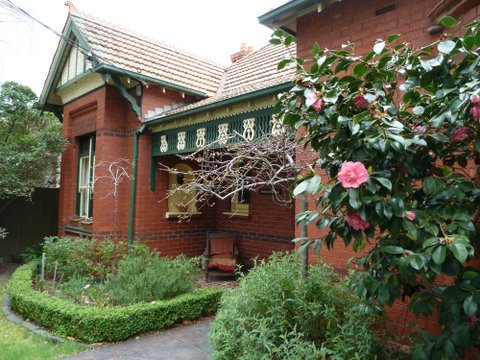This week the prompt shows a game of Canadian Gridiron players In action. Their superhero style outfits make them look very strange, although I realise that the helmets and heavy shoulder padding are designed for ultra protection from possible injury. Here in Australia four major football codes are widely played, and the players wear comparatively little protection, apart from occasional headgear. Aussie Rules players specialise in sleeveless jumpers and short shorts! Depending on State preferences, they play Aussie Rules, Rugby League, Rugby Union and soccer. Gridiron is not widely played in Australia, but we do have a relative who plays in a local competition.
My late father-in-law Robert Featherston appears to have been a keen sportsman in his younger days and I thought you might enjoy seeing some evidence of this from his photo collection. The first photo is of him on the field, ready for action. I'm not sure where or when it was taken, but it may have been before he joined the RAAF in 1941. His son/my husband says he was told that his father played rugby for Victoria, and this may well be what Bob is dressed and ready to play here, although there's no accompanying description. If that is correct, it must have been pre WW2.
The next photograph is an action shot, with a prematurely balding Bob down on his knees in the thick of things, during what I think is an Aussie Rules game, as some of the other players look to be the same as in the following team photo. When Bob returned to Australia after 3 years of imprisonment as a POW in Poland, he was sent to a one teacher school in the small town of Willing South, in Gippsland Victoria. His wife Mary says she always felt that in light of Bob's gruelling experience as a POW, it was rather mean of the Education Department to send him away to such a small and isolated place, far from his family in Geelong. He joined and played Aussie Rules with a local club, Gormandale FC, probably for companionship as much as a desire to play, and as the third photo shows, the team won their local premiership that year, in 1946. Strangely, when I had a look on the club web site, I saw that the honour board records recorded that a premiership had been won in 1947 but not 1946, so I've sent the secretary a copy of the photographic evidence and am hoping the records may be set straight as a result. Credit where credit is due!
Some fifty years later in the mid 1990s, several of Bob's grandchildren showed sporting prowess too. One swam competitively and a couple of the girls became gymnasts. Kim, one of our boys, was good at a variety of ball sports, playing tennis, soccer, baseball and later volleyball at district representative level, while his sister Claire played a good left-handed catcher for her softball team, the Kissing Point Black Sox, and was also part of a state championship winning team. Below are a few sporting photos of Claire and Kim.
Winners are grinners - U14 State Softball champions, Dubbo NSW 1993. Claire is on far left, 2nd row. A black and white photo that has effectively become sepia toned.
Claire the catcher in action, c. 1994/5
North Shore baseball rep players in the dugout, c. 1996
Soccer U14 Ku-Ring-Gai district winners - not surprisingly, Kim has the ball.
Sadly their grandfather was no longer around to enjoy their achievements, but I'm sure he would have approved.
Here is another action shot for you, showing a rugby lineout. I took it at the high school one Saturday afternoon in the winter of 1996 when the Barker College Rugby First XV were playing. The school was running a photographic competition at the time and surprisingly enough I won that week with this photograph and scored myself the prize of a handy little pair of binoculars. My photo was also printed on the cover of the weekly football program a few weeks later. Meanwhile our son was playing soccer, not rugby! Both this and the b+w soccer team shot were taken and developed by yours truly at a time when I was into that kind of thing.
On a previous trip to London last year, I looked out a window overlooking Peckham Rye Park and spied this set of four Aussie Rules goalposts in the nearby park, so clearly someone must be playing the game over there. Then just this week we received this appropriate photo of our little cutie, with her uncle Kim's Aussie Rules Sherrin in hand, getting in practice for her grandfather's upcoming visit.
Go Geelong! Not doing too well this year, so they need a bit of support!
Geelong socks for Isabelle when she's watching on TV with her English Dad, who is a Liverpool fan.
For other sporting blogs this week, get your kit on and play around at Sepia Saturday #277































